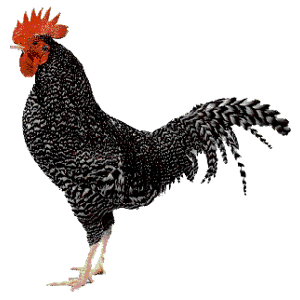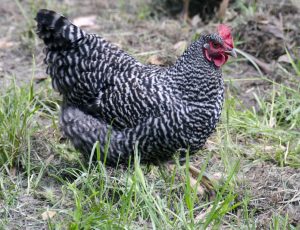
Breed Overview
Formally known as the Scotch Grey, this great breed was once very popular in Scotland. Its not less so and on the rare breed survival list. They are a very old breed dating back to the 16th century. Its known under different names so tracing it precise origins and roots is difficult. However, historians think the breed was bred from Scottish native fowl.
The males weigh 3.2kg and the females weigh 2.25kg.
Eggs
Size
Large
Color
Cream/White
Production per year
120-180
When do they start laying eggs?
Between 18-24 weeks
Scots Grey Characteristics
Temperament / Are they good as pets?
They make excellent pets as their temperament is very gentle. The males don’t tend to be naturally aggressive either.
How do I tame Scots Grey chicken?
Handling them as chicks is the best way to start. 2-3 times a day as young birds is great as it gets them used to being handled and they then associate you as being ‘safe’. If you get a scots grey as a adult or pullet start by feeding them from your hand they are an alert bird so will pick this up very easily. Treats like meal worms work great too!
How many do I need to buy?
Bought in pairs is what I recommend, not buying singularly. Chickens are social creatures and whilst scots greys do well in free range outdoor conditions, they like company too. Id say a small flock in your backyard of 6 is a great number. You can easily scale up from 6.
How much space do they need?
11sqft per bird is minimum for any breed. The scots grey is slightly different in that they don’t tolerate confinement that well. If you plan to keep this breed in a large open free range setting, they will be at their happiest. If you currently have scots grey and it appears unhappy or wont lay eggs etc give it more space. They will develop destructive habits when confined to a too smaller space. This breed also likes to roost in trees and make excellent foragers. They are a very hardy bird suiting all conditions.
Will they mix with my other chickens?
Yes they will mix well with other chickens of the same breed and other breeds. They are very content in a flock. I will always see mine singularly out in the grass foraging for grubs and insects, this is normal.
The males are quite ‘active and lively’ during mating season, you’ve been warned.
Appearance
The Scots Grey is a upright bird with long legs. Its look very similar to a Barred Plymouth Rock and is often confused as being so. The difference being that the Scots Grey are slenderer and the barring is less prominent.
They have one single recognised color pattern that is barred. They have red earlobes and a single comb. The feathers on the males around the neck and saddle can go a brassy color with birds kept outdoors that get a lot of sun. This is completely normal and just a pigment change within the feather.

Feeding
What should I feed them?
Good question, lets explore that. Chicks will eat ‘chick crumb’ or ‘chick starter’ this is specially developed to give them everything they need, nutrients wise, for this stage in their lives. Feed Scots Greys this up until 6 weeks old.
At 6 weeks switch this out for ‘growers mash’, your gorgeous chicks are now well on the way to becoming amazing egg laying adults. The growers mash contains 15-16{cfcd481556a8b43fba6af451761032bd323e94372a0c1e607} protein which help form the building blocks for growth.
18 weeks is a crucial time. So at 18 weeks switch out the growers mash for ‘layers pellets’ or ‘layers mash’. At this stage they will begin to start laying you some gorgeous eggs. Special pellets such as layers pellets are designed as a balanced diet for laying hens and hens on the ‘point of lay’.
How much should I feed them?
So typically laying hens will consume 2.9oz (80g) to 4.2oz (120g) a day of feed. This is an average and does depend on the climate in which you live. When its hot, chickens will tend to eat less and when its cold they may eat slightly more. They will eat slightly more as they are burning more energy to keep warm.
With chicks I never ever place a set weighed out amount per day of feed. I constantly have feed in the feeder. They will regulate and dictate how much they want, as they are growing so fast.
Breeders Top Tip: When it is hot, you can supplement some feed with high water content foods that chickens love, like watermelon!
What can’t they eat?
This goes for all chickens infact plus many domestic animals too, they can’t eat beans or chocolate. Why? – because its deadly, infact these foods cause cardiac arrest in chickens. Yes they are that harmful to them! Dried beans are infact worse than non dried. These foods could creep into the diet of your chickens by accident through feeding them scraps from the dinner table. So be really really vigilant.
This is worth noting but may go without saying anything moldy shouldn’t be given to chickens. A good rule is if you wouldn’t eat it, the chickens probably shouldn’t either.
What do I need to keep chickens?
Ok lets start with the basics a coop something with good roosting bars with ample spacing. Something with good ventilation all year round and ofcourse nesting boxes where the chickens will lay your beautiful eggs. If it’s off the ground this is a double bonus. Chicken feel safer off the ground so they will be happier. Plus too, that area will provide shade underneath, something in the summer that chickens love. This coop would work well or something very similar….
A feeder, now id always say, having kept chickens for many years (decades!) get something metal. It will last a lot longer than anything plastic with the heat and cold of summers and winters will degrade and break easily.
A waterer, again go with something metal. Its a lot longer lasting and will keep the water cooler for longer than plastic ones. Chickens prefer cooler water. It also slightly heavier meaning it less likely to get knocked over. If they knock it over in the morning and your out all day that’s the whole flock with potential dehydration.
